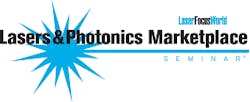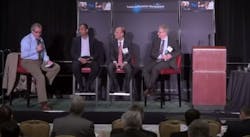Laser Marketplace: Forging innovation: Laser Marketplace Seminar review
Held on February 3 in conjunction with SPIE Photonics West 2014, the 2014 Lasers & Photonics Marketplace Seminar took both a quantitative and qualitative approach to the lasers and photonics markets. It complements the Annual Laser Market Review & Forecast feature article in the January 2014 issue of Laser Focus World as well as the comprehensive “The Worldwide Market for Lasers” report from Strategies Unlimited (Mountain View, CA), the market-analysis arm of PennWell.
If you weren’t able to attend the Seminar, the following presentation notes may pique your interest in attending next year (these tidbits serve at least as hints of the full discussion that took place).
Allen Nogee quantifies the laser markets
Strategies Unlimited’s senior analyst of lasers & LED lighting, Allen Nogee, reported that 2013 laser sales grew to $8.8 billion—modest 1.7% growth over 2012 laser market sales of $8.6 billion and below the 3.5% growth that we forecast in last year’s laser market review, primarily due to increased weakness in the optical storage sector, lithography, R&D, and military laser sales. For 2014, the forecast for worldwide laser sales is a healthier 6% increase to $9.3 billion.
Nogee noted that each year, China sells more and more lasers and buys less from U.S. and European suppliers. For 2013, China purchased $750 million in lasers and sold $280 millions’ worth. Since laser sales slightly lag but overall track the stock market, 2014 is foreseen as a bullish year, with communications lasers still leading the applications mix followed by materials processing and medical lasers. Mid-infrared (mid-IR) spectroscopy and flow cytometry join the ranks of healthy laser sales products, along with medical lasers (which were not hurt at all by the medical device tax).
Mark Douglass of Longbow: Macroeconomic overview
The laser markets (and especially industrial laser sales in tooling applications) are closely tied to the global economy, Douglass noted. Douglass sees a transition to industrial growth in 2014 after the industrial activity peak in the summer of 2012 following the recession of 2008/2009. Though the Purchasers Manufacturing Index (PMI) just fell recently and the stock market has shown a dip, these are short-term trends and optimism is growing that the global economy is gathering steam.
Although China’s PMI contracted in December and January 2013, China is relying more and more on internal growth rather than depending on Europe and its woes. And while double-digit China growth is unsustainable, 7.5% growth in GDP isn’t half-bad. The U.S. favorable three-year outlook does have some pitfalls: Douglass said that you only need 170 workers today to do the work of 1000 in 1950, and that we have only recovered 22% of the jobs lost in the great recession vs. an 82% recovery in production. Despite the unemployment prospects, more and more industries will continue to automate and lasers are a big component of that formula.
OSA’s Tom Hausken emphasizes ‘early peak’ photonics
Rounding out the morning market-focused presentations was a presentation from the senior engineering and applications advisor for The Optical Society (OSA; www.osa.org) and OIDA, Tom Hausken. His look at “The Optics Market: From the Exotic to Commodities” summed up the optics industry as comprising $24.5 billion in free-space optics, $11 billion in optical fiber, $0.5 billion in planar technologies, and $20 billion in vision correction, totaling $56 billion for the optics industry.
Hausken explained that overall sales growth is not based on the continuing growth of any one application space, but is really the addition of a series of “early peak” application sales that rise steeply and then taper off, and yet add to a steep (or healthy) growth curve. Like Nogee, Hausken sees sensing and medical applications as being key to future growth in the optics industry.
Executive panel cites opportunities
A rapid-paced, informative Executive Panel entitled “Global photonics market, trends, and opportunities” was moderated by Nufern president Martin Seifert. Panelists included Søren Isaksen, chairman of the Board of Directors, Photonics Group, NKT Holding A/S; Peter Leibinger, managing partner and president, Laser and Electronics Division of Trumpf; and Sri Venkat, senior VP/GM, Commercial Lasers and Components, Coherent.
For details of the panel sessions, including the full proceedings and video, please contact Adrienne Adler ([email protected]).
Needham’s Ricchiuti on 3D printing/LAM
James Ricchiuti, managing director, Equity Research at Needham & Company, detailed the history and future of 3D printing, a subset of which is laser additive manufacturing (LAM). Wohlers Associates pegs the 3D printing industry, both laser- and non-laser-based, at $2.7 billion in 2013.
Ricchiuti says that while there is plenty of hype, much of the activity is real. Dental is big, and GE says they will have 100,000 different designs in five years for 3D-printed components. Boeing already uses 32 laser-sintered components on the 787 aircraft, and additive manufacturing of metals will continue to be the growth driver. All indications, says Ricchiuti, are that 3D printing market estimates could be conservative.
Dennis Matthews on biophotonics
Dennis Matthews, director of the NSF Center for Biophotonics Science and Technology (University of California at Davis), surveyed the biophotonics field and market, naming many biophotonic tools and their applications, including lasers (ultrafast and others) for surgery, photodynamic therapy to kill cancer cells, and hyperspectral imaging to recognize unhealthy tissue in normal tissue. Even a cell phone itself can be a powerful biophotonic device: a $2 lens can turn a smartphone into a 200X transmission, polarization, or fluorescence microscope.
The biophotonics market is now $50 billion worldwide, which includes $37 billion for diagnostics, $6.2 billion for therapeutics, and the rest for research and other areas. This is predicted to rise to $190 billion by 2018. Matthews emphasized one important task for biophotonics: to bring health care to the patient whenever possible (remote and in-house diagnostics).
Drew Nelson gives the European perspective
Drew Nelson, president and CEO of semiconductor-wafer maker IQE (Cardiff, Wales) and president of the European Photonics Industry Consortium (EPIC), noted that the key players in the European effort to boost photonics manufacturing in Europe are the European Union (EU), with 28 nations; the Photonics21 association; and EPIC.
Photonics21 was founded in 2005 and has 200 members from all European countries. It has seven working groups: Information and Communication; Industrial Manufacturing and Quality; Life Sciences and Health; Emerging Lighting, Electronics and Displays; Security, Metrology and Sensors; Design and Manufacturing of Components and Systems; and Photonics Research, Education and Training.
EPIC is an industry-driven organization fostering a competitive ecosystem in Europe. Members of EPIC have access to the EPIC network, as well as access to EPIC pavilions at shows, technology workshops, and B2B roundtables.
This is all extremely important for Europe: in 2011, the total photonics market was €350 billion, which is estimated to rise in 2020 to €615 billion; with the European portion coming to €65 billion.
The next Lasers & Photonics Marketplace Seminar will be held on Monday, February 9, 2015, in conjunction with SPIE Photonics West 2015 in San Francisco.

Gail Overton | Senior Editor (2004-2020)
Gail has more than 30 years of engineering, marketing, product management, and editorial experience in the photonics and optical communications industry. Before joining the staff at Laser Focus World in 2004, she held many product management and product marketing roles in the fiber-optics industry, most notably at Hughes (El Segundo, CA), GTE Labs (Waltham, MA), Corning (Corning, NY), Photon Kinetics (Beaverton, OR), and Newport Corporation (Irvine, CA). During her marketing career, Gail published articles in WDM Solutions and Sensors magazine and traveled internationally to conduct product and sales training. Gail received her BS degree in physics, with an emphasis in optics, from San Diego State University in San Diego, CA in May 1986.

John Wallace | Senior Technical Editor (1998-2022)
John Wallace was with Laser Focus World for nearly 25 years, retiring in late June 2022. He obtained a bachelor's degree in mechanical engineering and physics at Rutgers University and a master's in optical engineering at the University of Rochester. Before becoming an editor, John worked as an engineer at RCA, Exxon, Eastman Kodak, and GCA Corporation.

